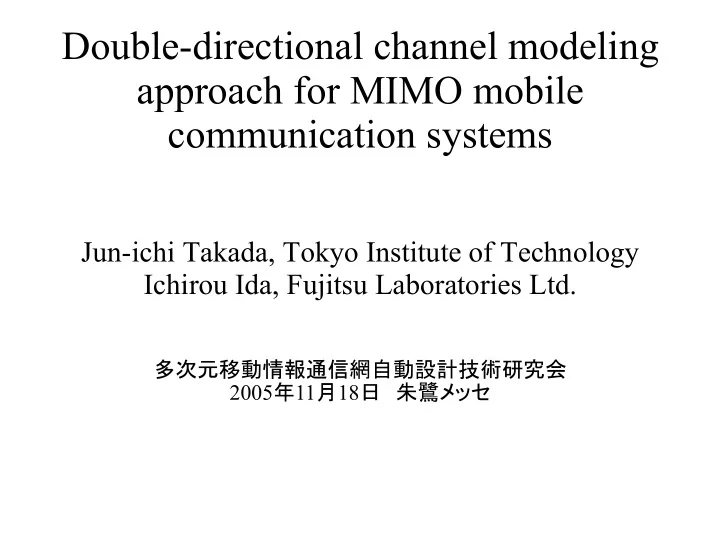

Double-directional channel modeling approach for MIMO mobile communication systems Jun-ichi Takada, Tokyo Institute of Technology Ichirou Ida, Fujitsu Laboratories Ltd. 多次元移動情報通信網自動設計技術研究会 2005 年 11 月 18 日 朱鷺メッセ
Introduction Array antenna technologies – Coverage : beamforming – Link quality : diversity (Tx/Rx) – Channel capacity : space division multiplex MIMO – Array antennas at both Tx and Rx
Outline ● MIMO channel and double-directional channel ● Approaches ● Issues for system level simulation This presentation ● does not present new results ● tries to provide some issues in propagation modeling ● tries to get the opinions from network engineers
Channel modeling strategy for MIMO transmission systems Performance of MIMO communication system is heavily dependent on MIMO channel property ● Array antennas – Part of transceiver Different elements – Freedom of design ● Propagation environment – Natural phenomenon – No control
Double-directional MIMO channel model channel model ● Array antennas are included. ● Array antennas are excluded. ● Transfer functions between ports ● Parameters of ray paths
Double-directional MIMO channel model channel model ● Array antennas are included. ● Array antennas are excluded. ● Transfer functions between ports ● Parameters of ray paths
Double-directional MIMO channel model channel model ● Array antennas are included. ● Array antennas are excluded. ● Transfer functions between ports ● Parameters of ray paths
MIMO channel matrix a t a r z θ x φ ζ, τ y MIMO channel can be modeled by double-directional path model.
Double-directional channel models for system level simulation Model requirement ● Continuous trace of mobile – dynamic behavior ● Macroscopic channel parameters – Ignored in link level model – Path loss – Shadowing ● Multiple base stations
Double-directional channel models for system level simulation Simulation Measurement Site-specific Ray Tracing Channel Sounding Stochastic 3GPP SCM N/A
Stochastic model ● Described purely mathematically ● Reproducible ● Not so realistic
3GPP-3GPP2 SCM Taken from [4].
3GPP-3GPP2 SCM Taken from [4].
Example A. Lozano, “The Industrial Embrace of MIMO: Reflections & Perspectives,” in Panel Session “MIMO Technologies – Since Then,” WPMC '05.
Site-specific model ● Location dependent ● More realistic. ● Question about “typical” and “standard” ● Two different approaches – Simulation based approach – Measurement based approach
Site-specific simulation model ● Numerical analysis of radiowave propagation ● Ray-tracing technique: high frequency approximation
Example Taken from [2]
Disadvantages in the ray tracing simulation Detailed map for scattering objects ● Commercial GIS database – Expensive – Other objects (sign board, light pole) not available High frequency approximation ● Error due to roughness and irregularity of surfaces
Site-specific measured model ● MIMO channel sounder ● Double-directional parameter estimator ● Synthetic channel for system level simulation – Measured double-directional channel parameters – Virtual array antennas
Example of channel sounder
Example T. Matsumoto, “Iterative (Turbo) MIMO Equalization Techniques,” Tutorial material in COST 273 MCM, May, 2003.
Issues in double-directional channel measurement ● Special array antennas – Small antenna spacing ● Parameter estimation techniques (e.g. MLE) – Influence from array geometry – Insufficient signal model ● Dense multipath within resolution ● Plane wave approximation
Current activities of the authors Double-directional channel measurement and modeling for beyond-3G mobile communication systems Center frequency 4.5 GHz Bandwidth 120 MHz Tx power 10 W 6.4 µ s Maximum delay Tx array 4 x 2 rectangular array, dual pol. Rx array 24 x 2 circular array, dual pol.
First measurement campaign ● small macrocell ● urban residential area 0 ● Height of BS: 30 m ● Scenario: non-line-of-sight (Red) ● Route length: 625 m ● Snapshots: 7 ss/m - + Tx
Data analysis ● Still ongoing – Instantaneous parameters ● Multipath fading ● Not yet started – Macroscopic parameters ● Shadowing ● Path loss
Issues of the double-directional channel measurement Some can not be solved... ● Limitation of parameter estimation – Insufficient parametric model – Finite angular resolution – Bigger problem in indoor ● Limitation of license – Base station position is strictly limited ● multi-cell measurement is impossible ● Limitation of coverage – 10 W Tx
Summary ● Double-directional channel modeling approaches – Most of the researches contribute to the models for link level only ● Open issue – Does antenna design really impact to the network performance in MIMO system?
Recommend
More recommend